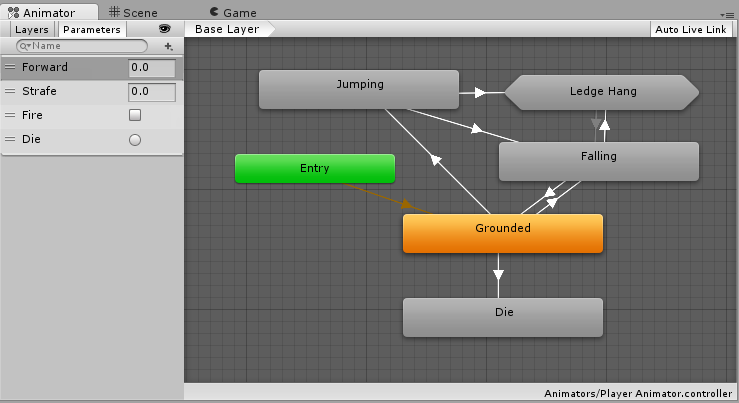Animator Window
Use the Animator Window to create, view, and modify Animator Controller assets.

The Animator Controller window always displays the state machineThe set of states in an Animator Controller that a character or animated GameObject can be in, along with a set of transitions between those states and a variable to remember the current state. The states available will depend on the type of gameplay, but typical states include things like idling, walking, running and jumping. More info
See in Glossary from the most recently selected .controller asset, regardless of which sceneA Scene contains the environments and menus of your game. Think of each unique Scene file as a unique level. In each Scene, you place your environments, obstacles, and decorations, essentially designing and building your game in pieces. More info
See in Glossary is loaded.
The Animator Controller window contains:
- Animation LayersAn Animation Layer contains an Animation State Machine that controls animations of a model or part of it. An example of this is if you have a full-body layer for walking or jumping and a higher layer for upper-body motions such as throwing an object or shooting. The higher layers take precedence for the body parts they control. More info
See in Glossary - Event Parameters
- A layout area where you create, arrange, and connect states for your Animator ControllerControls animation through Animation Layers with Animation State Machines and Animation Blend Trees, controlled by Animation Parameters. The same Animator Controller can be referenced by multiple models with Animator components. More info
See in Glossary.
You can right-click on the grid to create a new state node. Use the middle mouse button or press Alt (macOS: Option) and drag to pan the layout area. Click to select and edit a state node. Click and drag a state node to rearrange your state machine.

Use the Parameters view to create, view, and edit Animator Controller Parameters. These are variables you define that act as inputs for the state machine. To add a parameter, click the Plus icon and select the parameter type from the context menu. To delete a parameter, select the parameter in the list and press Delete (macOS: Ctrl+Delete).

Use the Layers view to create, view, and edit layersLayers in Unity can be used to selectively opt groups of GameObjects in or out of certain processes or calculations. This includes camera rendering, lighting, physics collisions, or custom calculations in your own code. More info
See in Glossary for your Animator Controller. You can control each layer with a different state machine. For example, you can have a base layer that controls the overall animation of your character and a second layer that controls the upper-body animation of your character.

Enable or disable the Eye icon to display or hide the Parameters and Layers side pane. Hide the side pane to have more room to edit your state machine.

States can contain sub-states and blend trees. You can nest these structures repeatedly. When you are viewing a sub-state or blend tree within another state, the breadcrumb list displays the nested hierarchy. Select an item in the breadcrumb list to display the state, sub-state, or blend tree.

Enable the lock icon to focus the Animator Window on the current state machine. When the lock icon is enabled, the Animator window shows the same state machine regardless of whether a different animator asset or GameObjectThe fundamental object in Unity scenes, which can represent characters, props, scenery, cameras, waypoints, and more. A GameObject’s functionality is defined by the Components attached to it. More info
See in Glossary is selected. When the lock icon is disabled and you select a different animator asset or another Game Object with an animator componentA component on a model that animates that model using the Animation system. The component has a reference to an Animator Controller asset that controls the animation. More info
See in Glossary, the Animator Window displays the state machine for newly selected asset or GameObject.